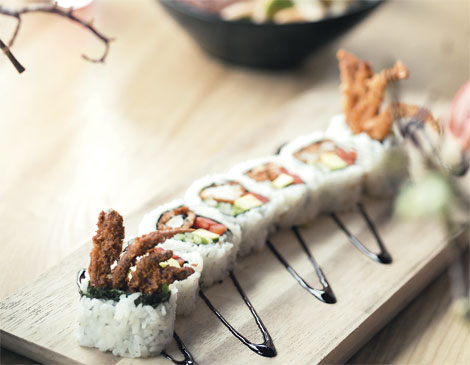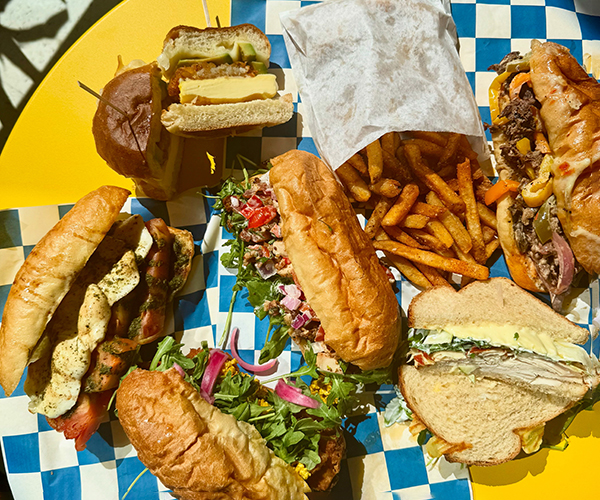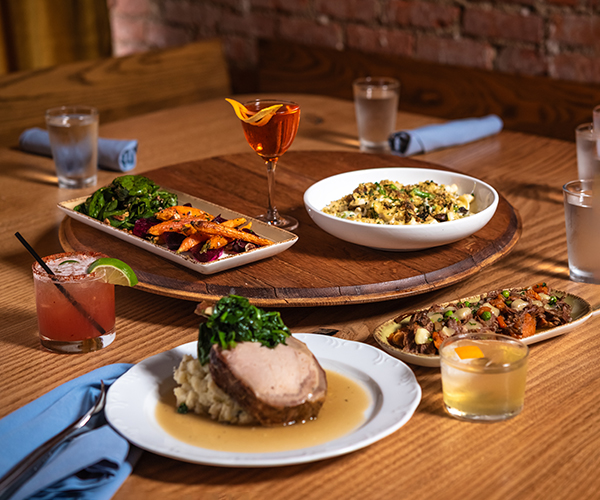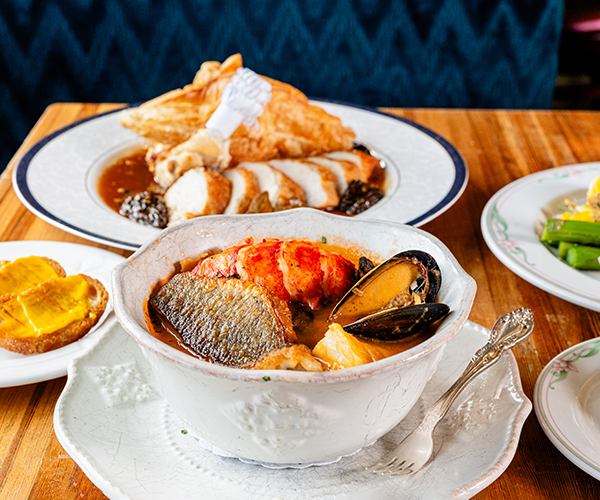There is an art to sushi-making and a centuries-long tradition surrounding the etiquette and practice of eating it.
Sushi first appeared around eighth century Japan in the form of fish wrapped in fermented rice. The delicacy as we know it today was invented in Edo (modern-day Tokyo) at the turn of the 18th century — more than 200 years ago — as a type of street food that could be eaten on the go.
Just as tea ceremonies in Asia have evolved to form a distinct culture, sushi too has developed its own set of rules. For instance, it's perfectly polite to eat sushi with either your fingers or chopsticks. But don't mix wasabi directly with your soy sauce — add a dollop to the top of each bite instead. And if you need it, the correct way to season sushi is to flip it, fish side down, and dab sparingly into a tiny pool of soy sauce.
Naturally, food held in such high regard is not easy to create. Sushi chefs spend several years training to make perfectly plump, well-seasoned rice, to slice the raw fish just so and to meticulously arrange each into edible art.
Yet, like painting or sculpture, sushi is also an expression of the artist.
The July opening of Voodoo Tuna in Lakewood introduced what you might call postmodern sushi.
Chef and owners Joe Koskovics, 29, and Andrew Jackson, 24, didn't go through a multiyear apprenticeship in Tokyo. And they won't take offense if you dip your rice in soy sauce.
"Most sushi places, you can go anywhere and get the same exact thing," Jackson says. "So we wanted to try a lot of different ideas."
"The biggest surprise — that could be either an excitement or a letdown — is that we're not traditional," agrees Koskovics.
But if you're the type who enjoys a culinary adventure, Voodoo Tuna's clear departure from the expected ought to excite you.
Sushi options are divided into five categories: The traditional uramaki are simple two- to three-ingredient rolls such as the ubiquitous California roll (crab stick, avocado and cucumber, $8). Voodoo's signature maki creatively plays on the classics such as the house-favorite crab Rangoon roll ($8) made with crab salad, cream cheese and spicy mayo that's tempura dipped and fried.
The traditional futo maki — larger rolls with more ingredients — include the Black Widow ($18), a spider roll with soft shell crab, cucumber, avocado and red pepper. Voodoo's signature futo maki dives into the creative deep end with popular combos such as the tempura shrimp, pork belly, scallop and avocado version called the Sea Swine ($17).
Finally, there's sashimi or nigiri ($6-$8), plain slices of fish served with wakame seaweed salad or sliced fish atop blocks of rice, respectively.
Koskovics first learned to make sushi at Willoughby's Lure Bistro about five years ago, when the restaurant's sushi chef unexpectedly resigned. After training for several weeks, he picked up the basics and proceeded to teach himself on his own time from textbooks and YouTube videos.
"Because I've never been taught by a sushi chef and I never went to [culinary] school, I never had any boundaries," he says.
Combining unexpected ingredients into off-the-wall sushi rolls such as a Slim Jim roll — a combo he calls funny and swears you'll never see on Voodoo's menu today — "was a stepping stone to getting to where we're at but using nontraditional sushi items with sushi."
It's a fairly even mix of traditional-to-twisted sushi at Voodoo, with more than 25 rolls and close to a dozen sashimi options to choose from. But sticklers be warned: Even standard rolls taste unique to Voodoo Tuna, as sauces — such as spicy mayo (a staple in the spicy tuna roll, $9) — are distinctive from other local sushi mainstays such as Pacific East and Ginko.
Whether better or worse, that's for each diner to decide. But if you've never strayed beyond the safety zone in exploring this Japanese cuisine, Voodoo Tuna's fusion versions are as good a place to start as any. The restaurant and cocktail lounge adjacent to Humble Wine Bar is already a hit in the neighborhood, thanks in large part to owners who understand the area's playful vibe.
Both Koskovics and Jackson are young for the high-stakes restaurateur game. Yet the duo has worked together since Jackson first started cooking just five years ago, working his way up from bussing tables in Willoughby to helping Koskovics bring sushi to Ballantine during a menu shake-up several years ago.
Their first half-crazed sushi creation, a Voodoo Tuna roll made with roasted Fresno peppers, wasabi cream cheese and strawberries, even lends the restaurant its name. Two other partners not involved in the daily operational decision-making helped tie together the funding to turn a defunct Dot's women's clothing shop into the area's primary sushi spot.
"We looked around at a few locations," says Jackson, who has lived in and around Euclid for most of his life.
Why Lakewood? "No sushi," he and Koskovics answer simultaneously.
But while sushi is Voodoo Tuna's bread and butter, so to speak, there's a lot more to the menu than just raw fish and rice. In particular, any one of the restaurant's seven varieties of steamed buns are a safe bet for a satisfying few bites. The orange beef bun ($8 for two) is a symphony of varying sensations as the softly steamed dough holds together crispy fried kale and grilled beef tenderloin glazed in a not-too-sweet orange chili sauce.
Nearly all eight of the appetizers are spot-on as well. Bright chicken and lemongrass pot stickers ($8) are served over a green tea noodle salad just as good as the star of the dish. And an interactive sushi roulette ($12) is fun to share (Who will get the bite loaded with a knockout dose of wasabi?).
Beyond the food menu, Voodoo Tuna is on the fast track toward becoming yet another West Side cocktail haven.
The drinks aren't cheap, but you get what you pay for — from a Tokyo mule, ($10) made with sake that somehow highlights the delicate rice wine rather than mask it in the spicy flavors of ginger beer and lime, to an intriguing, booze-forward mixture called the Final Word, ($10) made with Nikka Coffey grain whiskey, green chartreuse, a Luxardo cherry and a smoky charred-thyme garnish.
There's also a curated sake and soju menu 10 bottles long, including a lightly sweet, milky-white unfiltered gem called Ozeki Nigori ($14).
There's a lot to choose from at Voodoo Tuna, whether you know your way around a pair of chopsticks or not. The only thing you really need to remember here is to have fun.
"We are doing our own take on Asian fusion," says Koskovics. "We always like to still incorporate something traditional that comes back to the roots of traditional sushi, but we're casual to the [point] that if someone wants to eat sushi with a fork, it's not a problem."
WHEN YOU GO: Voodoo Tuna, 15326 Detroit Ave., Lakewood, 216-302-8862, voodootuna.com, Daily 4-10 p.m.
good to know: There's always a deal to be had here. For regulars, a daily happy hour menu - 4-7 p.m. when you sit at the cocktail or sushi bars-features half-priced uramaki rolls and appetizers plus a list of $4 draft beers. Regular special events such as a recent five-course meal with an expert-guided beer tasting for $40 round out the offerings for destination diners.
Sake Sampler
Our sipping notes from a sake tasting at Voodoo Tuna
Thanks to chefs Joe Koskovics and Andrew Jackson — plus a little guidance from Matt, a sake and wine rep from Glazier Beverage, we're feeling much more adventurous when it comes to Voodoo Tuna's sake menu. Here are our tasting notes to guide your next visit.
The Basics: Sake is a fermented alcoholic drink made from rice. Generally, the more refined the rice, the finer the sake, though there are exceptions. In order from least to most refined (that is, the more bran that is polished off each grain of rice), the basic sake classifications are as follows: Junmai, or 30 percent polished; honjozo, or 30 percent polished with a small amount of distilled alcohol added; ginjo, or 40 percent polished; and daiginjo, or 50 percent polished. Try this: Genbei Onikoroshi Honjozo (+5), light with a smooth mouthfeel
Sweet and Dry: Unlike wines, sake menus are crystal clear when it comes to how sweet or dry your beverage of choice is bound to taste. In fact, the balance between sugar and alcohol percentage — known as Nihonshu-do, or sake meter value — is actually measured and printed right on the label. The higher the number the drier the sake, and vice versa. Try this: Ozeki Nigori (-30), milky white appearance from unfiltered rice sediment gives this sake a velvety texture and sweet, starchy taste
Hot or Cold: The more refined the sake, usually the more complex the flavor, which is usually best highlighted when the liquid is slightly chilled. Some seem to "bloom" with gentle heat, however, and ultimately it's up to you. Again, the label will usually tell you the recommended serving temperature. Try this: Kaori Junmai Ginjo (+3), clean and refreshing with notes of pear and cucumber and floral aromas
Origin: Most sakes are produced in either Japan or the U.S. But while neither can claim superiority — each takes on its own flavor based on terroir, as in winemaking — if you really want to know which is which, look again to the label. Japanese labels won't contain any English at all, while U.S. sakes will usually provide a translation. Try this: Kira Honjozo (+15), sharp and refreshing with a mild bitterness and gently unfolding finish
Sipping vs. Shooting: Yes, sake cups are small like shot glasses. And yes, you can shoot sake, which on average contain more alcohol than wine. But high-quality sakes are meant for sipping, like a good bourbon would be wasted with a beer chaser. Try this: Kaguyahime Junmai (-2), a bright and slightly acidic but mild sake




